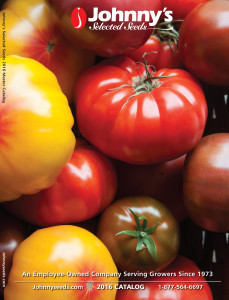A friend and I were discussing the demerits of a college education the other night, railing on about the obscene tuition and the likelihood of getting a debt-weighted liberal arts degree only to pull coffee shots or sling pizza dough afterwards…that coupled with the irony that there has never been a an easier time to acquire the information dispensed by our institutions of higher learning. Between the public library system and a good Wi-Fi connection, you’re pretty much in touch with “All That Is Known”. Now this isn’t an education reform blog, so I’ll stop there on the college thing, but I will say that something slimly analogous exists with gardening.
In winter’s darkest days a light comes forth from the mailbox, yes, an actual physical piece of mail in the mailbox – the exalted SEED CATALOG! Image courtesy of Johnny’s Selected Seeds.
Some people think that to learn gardening one should attend a class or buy a few books. Hey, I don’t discount that such a course may help you, but there is a cheaper way to get all that knowledge and more without even the effort of stepping outside your door: the seed catalog. Starting around Thanksgiving, I begin to receive some of the true lights of winter….those glossy little magazines brimming with photos of summer tables and bounteous crops. These act not only to fortify my spirit around the dark winter solstice, but they are also a complete gardener’s education in themselves. Seed catalogs are not all equal, but generally here’s what I might hope to mine from any given catalog.
First and invaluably, there are the photos of the crop varieties. Despite an overall lamentation that we have lost a huge percentage of vegetable varieties that were grown in the early 1900s, there still is an overwhelming amount of choice in what to grow each season. Seeing a photo or two (albeit an often sexed-up version of the crop) can help steer you in a particular direction as can the brief verbal description of the variety. While some catalogs will promise that every variety will “taste great”, others will try to be a little more honest about the trade-offs that all varieties necessarily make. For example, one type of sweet corn might germinate well in cool soils, making it ideal for the earliest crop, and I’d be willing to bet that this precocity was bought at the sight expense of sugar, but if you live in upper Michigan, the trade of early (meaning you actually get corn versus just growing very tall grass) versus a bit more sweetness to your corn may be one you’ll gladly make.
Of course the seed catalog is designed to make you want to buy things and is in that sense propagandistic, so the gardener has to develop an ability to read a little between the lines and guess educatedly about what really is being said beneath all that “great tasting” rah-rah. Watch out for words like “acceptable”, as in ” This variety ripens tomatoes when nights are 50 degrees, with acceptable taste.” Chances are you might apply the words “mealy” or “barely better than store bought”. Evaluative wisdom comes with experience, so try what varieties you think will be good and see if the reality lives up to the description.
Not uncommon to see in seed catalogs are cooking notes and recipes, and I admit to having been swayed toward a particular crop by a mouth-watering side bar. We are, for the most part, going to eat the offerings in a seed catalog, and besides herbs, which are sui generis (and so generous) in flavor, we mostly will be looking for ways to combine crops in the kitchen for better effect. If a catalog tells me that a particular variety of summer squash has a nuttier taste and firmer flesh than its counterparts, I may be swayed toward it, thinking about its performance on the grill. If I have grown ground cherry in the past and used it only sparingly, I may be motivated to grow it again if I see a photo of it dipped in chocolate….hmmm, never thought of that!
Beyond the particularities of variety, there are also the characteristics of the crop as a whole, as in whether your peppers are red, yellow, orange, skinny or fat, they are still peppers, Capsicum annum, with common needs and preferences. So usually there are some notes at the head of each section about the generic crop requirements. While some of these seemed aimed at those with a Twitter-feed attention span, other catalogs take you as a gardener very seriously and provide substantial growing information: everything from when to plant to when to harvest to how to store to what kind of pests and disease you can expect (and what to do about it). Some catalogs are just-the-facts-ma’am plainspoken, others revel in the rich cultural histories of crops and varieties, and I won’t say that I don’t enjoy these mini-history lessons and digressions.
Finally, don’t ignore the tool and gear section. Here you will find a parsing-out of the merits of various hoes, a bevy of season-extension equipment, special knives for harvest, non-kinking, lead-free hoses, and maybe some functional garden art. There is usually also a book section, but if you’ve received a few catalogs in the mail, you can skip that. You’ve got everything you need in those catalogs…for free!
As a grower, my favorite catalog is that of Johnny’s Selected Seeds, which is a virtual Harvard University of growing information. Access it online at: http://www.johnnyseeds.com/, but I recommend the paper catalog as well. It’s a day-brightener during the gloom of winter.

